The book Moments of Idleness by the Buddhist monk Yoshida Kenkō dates to 1330. If one randomly opens the book even today, encounters a landscape, a gesture, an object, a word, an anecdote, a facial expression, all serving as elements for contemplative reflections.[1] Precisely on a par with this suggestion is the encounter with the works of Polina Barskaya (1984, Cherkasy, Ukraine), who from 2 February to 2 March 2024 will be the protagonist of a solo exhibition at the Kristin Hjellegjerde Gallery in West Palm Beach.
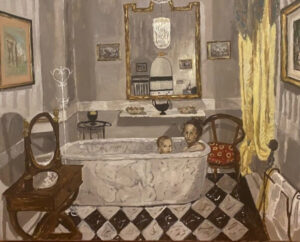
Polina Barskaya, Florence Bath, 2023, acrylic on canvas, 61 x 76 cm, courtesy the artist andKristin Hjellegjerde Gallery West Palm Beach, Florida, USA
These works are characterized by a sharp and intense visual tone, typical of a narrative sprinkled with flavorful, dry details. The sentiments of boredom and idleness are given a slow and articulate maturation within this exhibition. What the monk Kenkō narrates, where the world is sung and admired in its harsh simplicity, is also captured by the artist Barskaya, who lives in a state of mimicry between her painting activity and her own family nucleus. This enchanting relationship is well-documented in the film POLINA BARSKAYA: in process by Alexander Kaluzhsky (2021)[2], where the painter’s daily ritual is depicted, marked by intimate times in the context of a rural province that allows her to focus on the normal rhythmic physiology of life. What emerges from the documentary, characterized by a slow, rough lyricism, entirely devoid of visual embellishments, retaining the charm of silent cinema, is well reflected in the exhibited works. They are united in being raw narrative scenes, devoid of any complacency towards others and even less towards oneself, with no difference between the narrated fact and its introspection.
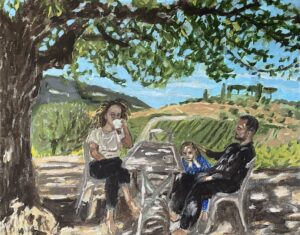
Polina Barskaya, Summer, 2023, acrylic on canvas, 20 x 23cm, courtesy the artist and Kristin Hjellegjerde Gallery West Palm Beach, Florida, USA
Turning attention to the exhibited works, the key role of time emerges, essential for internalizing one’s own life condition with calm tranquility, thereby contrasting the fast and voracious consumption of emotions that characterizes contemporary life. As an observer of her own and others’ souls, the artist, in a leisurely stretched time, prefers to depict moments of natural intimacy in interiors or airy settings known for their immediate evocative power. In most of Barskaya’s works, her face remains undaunted, staring at us with large eyes characterized by an impassive and magnetic fixedness, posing a clear question to anyone who looks upon it about the value of portraiture. Portraiture is considered a pictorial genre capable of touching on the ontological problem, namely the identification of an identity and the announcement of its otherness. It is this latter aspect that gives the works a strongly metaphysical character due to their exquisitely cold realism, in which every psychological breath is deliberately limited to inversely emphasize attention to the figures and their reciprocal sensations and emotions.
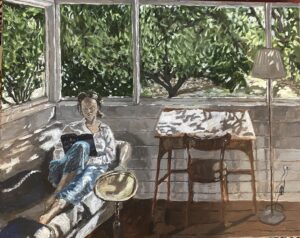
Polina Barskaya, Reading, 2023, acrylic on canvas, 61 x 76 cm, courtesy the artist and Kristin Hjellegjerde Gallery West Palm Beach, Florida, USA
This element is reinforced by Barskaya’s painting practice, which involves working on her model not based on the simple fact but rather using photographs. Although these photos do not become part of the actual creative process, they are used as straightforward data, akin to witnesses devoid of aesthetic value. If, as some argue, «photography has clearly specified what the transitive painting of feelings was and what descriptive painting was»[3], for the artist, painting follows the thread of description, or better yet, narration, never that of emotional exposure. This approach allows considering the works as fragments of a broken narrative, moments of pause, where none of the characters do anything specific except rest or experience an enveloping and regenerative state of meditation. Thus, Barskaya’s entire production assumes a constant cadence, living according to an order and rhythm in which, like in a pictorial film, scenes unfold conceived by a lucid and eminently pragmatic approach.
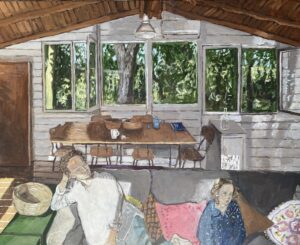
Polina Barskaya, At Madonella Agricola, 2023, acrylic on canvas, 61 x 76 cm, courtesy the artist and Kristin Hjellegjerde Gallery West Palm Beach, Florida, USA
The hidden metaphysics of the narrative that follows the painter becomes possible with attention turned to two conditions: the figure and the place, which come to life with the novel management of light spots. It is precisely this element that defines the backgrounds and brings to life the shadows of a subtle, changing veil. Thus, in the scenes that unfold, sometimes the protagonists are bathed in an amaranthine, fluctuating, and metallic glow. At other times, watery or differently vitreous tones reveal a brightness emanating not so much from the environment but directly from the characters and objects. However, in all cases, light is the true protagonist that highlights the modeling of the body and the splendid details, settling subdued on the receding planes to create pockets of shadow. At this point, it is inevitable to wonder if, for the artist, this element has a structural value, akin to a membrane that allows multiple exchanges, becoming responsible for the functioning of the entire painting. Thus, every time one looks at a work, a kind of inadequacy is felt, akin to a gap in the air stained with dew unfolding in the mystery of the introspection of the silent characters.
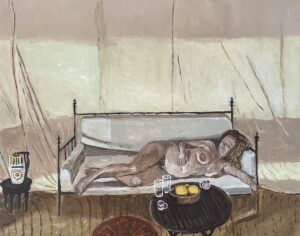
Polina Barskaya, Morocco, 2023, acrylic on canvas, 61 x 76 cm, courtesy the artist and Kristin Hjellegjerde Gallery West Palm Beach, Florida, USA
Even where various subjects are portrayed, they share a commonality, mute in their conditions, as Barskaya has no intention of staging a conversation piece. The artist combines the profound sense of physical presence with an equally paroxysmal urgency to express the inner condition and the secret, unconscious bond that exists with one’s affections. A subtle sense of irony is perceived, regardless of whether she portrays herself, her beloved daughter, or husband. This irony aims to focus attention first and foremost on identity. For this reason, the surfaces of the faces are exaggerated in their wrinkled naturalness and loaded with color accents, as if wanting to use painting as a tool to repropose the eternal dilemma between the body and matter. However, despite the strong scenic realism, something remains obscure in the paintings. Often, the characters are waiting for something to happen, and Barskaya’s effort is clear: to make us responsible witnesses and never mere spectators of a representation.
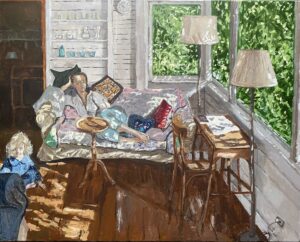
Polina Barskaya, Morning Sun, 2023, acrylic on wood panel, 61 x 76 cm, courtesy the artist and Kristin Hjellegjerde Gallery West Palm Beach, Florida, USA
In this way, the carefully calibrated brushstrokes, at times filled with a crystalline and glazed light, transfigure their life icons, allowing them to survive in the chaos of the world that the artist has consciously chosen to observe from a distance. Nothing more than this awareness invites us to hypothesize how Barskaya escapes from the concept of the abyssal banality of the portrait as a psychological definition, distancing herself from a swarm of interpretations that one might mistakenly rely on. The works are rather repositories of sensations; for this reason, they rise as testimonies of affections and emotional balances. Even if the subjects do not speak, they presuppose a story as deep as it is material. In other words, it is a painting triumphant in prose, a story of one’s life lived like a novel in pictures, where each scene unfolds through a fresh light, stained with drops of clear and fresh dew.
Maria Vittoria Pinotti
[1] Roberto Calasso, Momenti d’ozio di Kenkō, in Cento lettere a uno sconosciuto, Piccola Biblioteca Adelphi, Milano, 2003, pp. 78-79
[2] Il film POLINA BARSKAYA: in process di Alexander Kaluzhsky (2021) è visibile a questo link: https://www.youtube.com/watch?v=R7DKcNmbiGA
[3] Henri Matisse, Pensieri riferiti da Tériade, in Scritti e pensieri sull’arte, Giulio Einaudi Editore, Torino,1988, p. 74
Info:
Polina Barskaya
2/2/2024 – 2/3/2024
Kristin Hjellegjerde Gallery
2414 Florida Avenue, West Palm Beach, Florida 33401 USA
+1 (561) 922-8688 | info@kristinhjellegjerde.com
Opening hours: Tuesday to Saturday from 11:00 AM – 6:00 PM
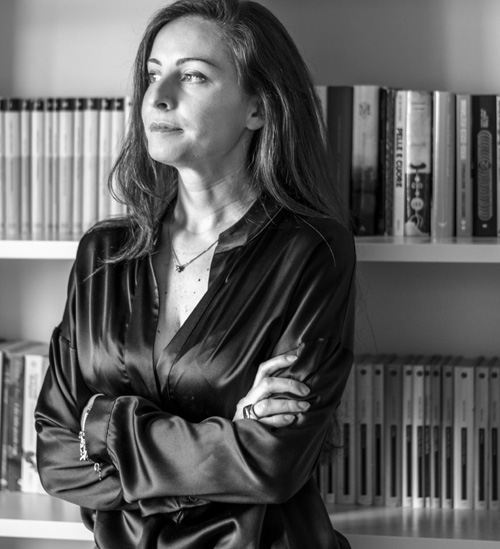
Maria Vittoria Pinotti (1986, San Benedetto del Tronto) is an art historian, author, and independent critic. She currently is the coordinator of Claudio Abate’s photographic archive and Manager at Elena Bellantoni’s Studio. From 2016 to 2023 she was the Gallery Manager in a gallery in the historic center of Rome. She has worked with ministerial offices such as the General Secretariat of the Ministry of Culture and the Central State Archive. Currently, she collaborates with cultural sector magazines, focusing on in-depth thematic studies dedicated to modern and contemporary art.






NO COMMENT